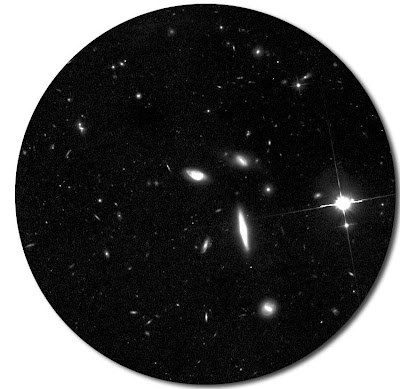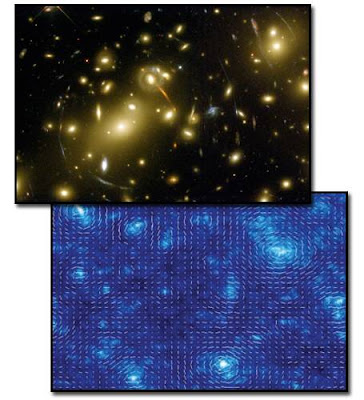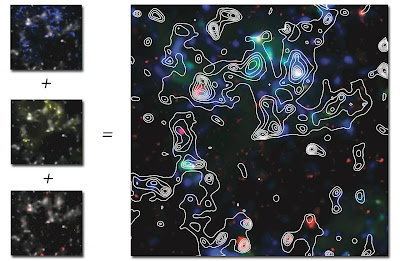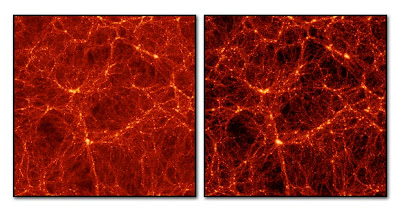
Visible-light images from the Hubble Space Telescope populate this tiny section of the full two-square-degree Cosmic Evolution Survey (COSMOS), which combines data in many wavelengths from space and ground-based telescopes around the world. COSMOS was the basis of a new extension of the mass-luminosity relation for weak lensing studies.
Berkeley, CA — Weak gravitational lensing is a uniquely promising way to learn how much dark matter there is in the Universe and how its distribution has evolved since the distant past. New work by a team led by a cosmologist from the U.S. Department of Energy’s Lawrence Berkeley National Laboratory has made major progress in extending the use of gravitational lensing to the study of much older and smaller structures than was previously possible.
Until recently, weak lensing had been limited to calculating the total mass of relatively nearby groups and clusters of galaxies. Their total mass includes both ordinary, visible matter like stars and dust – what astronomers call “baryonic” matter – plus the much more massive invisible concentrations of dark matter that form groups and clusters by pulling galaxies together.
Astronomers were able to establish an important scaling relationship for nearby clusters between their total masses, determined by gravitational lensing, and the brightness of their x-ray emissions, an indication of the mass of the ordinary matter alone. A new study in the Astrophysical Journal (ApJ) now continues this important relationship to distant objects.
“We’ve been able to extend measurements of mass to much smaller structures, which existed much earlier in the history of the Universe,” says Alexie Leauthaud, a Chamberlain Fellow in Berkeley Lab’s Physics Division and first author of the ApJ study. “This helps us gain a better understanding of the relationship between the normal matter in dense structures, which are seen through the x-ray luminosity, and the total dark-matter mass of these structures, as measured by the weak lensing.” Leauthaud is a member of the Berkeley Center for Cosmological Physics (BCCP) at UC Berkeley and Berkeley Lab.
Mass as a lens
Gravitational lensing occurs because mass curves the space around it, bending the paths along which rays of light travel: the more mass (and the closer to the center of mass), the more space bends, and the more the image of a distant object is displaced and distorted. Thus measuring distortion, or “shear,” is key to measuring the mass of the lensing object.
At least this is so for “strong” lensing. A very massive object or collection of objects, like a nearby galaxy cluster and the invisible dark matter that encloses it, distorts the apparent shape and position of bright objects beyond it so much that the distant images are bent and may even be smeared into rings around the foreground cluster. The visible distortion is a direct measure of the mass of the lens and points to its center.

A spectacular example of strong gravitational lensing is the nearby galaxy cluster Abell 2218 (top), in which the visible distortion of individual background galaxies can be used to measure the mass of the lensing structure. The weak lensing of fainter and more distant structures must be detected by statistical averaging (bottom). (Abell 2218 image by NASA, weak lensing simulation by Bhuvnesh Jain, Uroš Seljak, and Simon White)
Weak lensing works the same way, except that the shear is too subtle to be seen directly. Most of the apparent shear isn’t distortion at all – a galaxy has its own distinct shape, and we often see it from an angle that makes it look elongated. Apparent shear may also be due to the telescope, the detector, or the atmosphere.
Nevertheless, faint additional distortions in a collection of distant galaxies can be calculated statistically, and the average shear due to the lensing of some massive object in front of them can be computed. Yet to calculate the lens’s mass from average shear, one needs to know its center.
“The problem with low-mass, high-redshift clusters is that it is difficult to determine which exact galaxy lies at the center of the cluster,” says Leauthaud. “That’s where x-rays help. The x-ray luminosity from a galaxy cluster can be used to find its center very accurately.”
The hot intracluster medium of gas or plasma that fills almost all galaxy clusters emits x-rays, making x-ray emission a convenient way to find distant galaxy structures in the night sky. But how does this emission help find the center of mass in a galaxy cluster? For the same reason that dark matter is dark.
Why dark matter is dark
Except through gravitation, dark matter does not interact (or interacts only very weakly) with itself or with ordinary matter. Indeed, that’s why it’s dark: to emit light it would have to interact via the electromagnetic force.
With ordinary matter, electromagnetism affects everything from chemistry to luminosity to electric and magnetic fields and even the pressure of stellar winds; thus electromagnetism plays an important role in determining the arrangement of ordinary matter, which is often irregular.
Because electromagnetism plays no role in the distribution of dark matter, however, dark matter forms large, smooth, spherical clumps, usually filled by ordinary galaxies plus hot gas or plasma, which it has trapped and retained solely through gravitation.
“Gas density follows the dark matter density, and because x-ray emission scales as the square of the gas density, the x-ray light shines very strongly in the core of the structure,” Leauthaud explains. “So x-rays are an excellent way to determine the center of even a distant, fuzzy galaxy cluster.”
“Basically the more mass, the more heat,” says Jean-Paul Kneib, a lead author of the ApJ paper from the Laboratory of Astrophysics of Marseilles (LAM) and France’s National Center for Scientific Research (CNRS). “But the plasma is baryonic matter, which is only a small part of the total mass of the cluster. While the x-radiation tells you something about the total mass, you need to get the scaling just right.”

Visible matter follows an underlying dark matter scaffolding. At left, blue indicates the mass of stars in galaxies in a given area, yellow the number of galaxies, and red the sources of brightest x-ray emission. Contours at right are the distribution of dark matter, from gravitational lensing. (Richard Massey et al, Nature 2007.
To pin down the scaling relation between x-ray brightness and total mass, Leauthaud and her colleagues first used x-ray luminosity to identify the center of mass of 206 galaxy groups and clusters, including numerous faint, distant clusters listed in the Hubble Space Telescope’s Cosmic Evolution Survey (COSMOS), which is curated by Nick Scoville of the California Institute of Technology, an author of the ApJ paper.
X-ray imaging came from the European Space Agency’s XMM-Newton satellite and from NASA’s Chandra satellite, whose principal investigator is Martin Elvis of the Harvard-Smithsonian Center for Astrophysics, an author of the ApJ paper. Elvis says, “I never thought our Chandra data would enable such a great measurement. In fact I was astonished when Alexie first showed me the results. It’s quite a tour de force of analysis, and really convincing.”
The X-ray analysis itself was performed by Alexis Finoguenov of the Max Planck Institute for Extraterrestrial Physics and the University of Maryland, one of the paper’s lead authors. Knowing the centers of mass from analysis of x-ray emission, the researchers could now use weak lensing to estimate the total mass of the distant groups and clusters with greater accuracy than ever before.
Finally they calculated the mass-luminosity relation for the new collections of groups and clusters and found that it was consistent with previous relations established by surveys of much closer structures – including some studied with strong gravitational lensing. Within calculable uncertainty, the relation follows the same straight slope from nearby galaxy clusters to distant ones; a simple, consistent scaling factor relates a group or cluster’s total mass to its x-ray brightness, or “baryonic tracer.”
“By confirming the mass-luminosity relation and extending it to high redshifts,” Leauthaud says, “we have taken a small step in the right direction toward using weak lensing as a powerful tool to measure the evolution of structure.”
In the beginning
The origin of galaxies can be traced back to slight differences in the density of the hot, liquid-like early universe; traces of these differences can still be seen as minute temperature differences in the cosmic microwave background (CMB).
“The variations we observe in the ancient microwave sky represent the imprints that developed over time into the cosmic dark-matter scaffolding for the galaxies we see today,” says BCCP director and UC Berkeley physics professor George Smoot of Berkeley Lab’s Physics Division, who shared the 2006 Nobel Prize in Physics for measuring anisotropies in the CMB and is one of the authors of the ApJ paper. “It is very exciting that we can actually measure with gravitational lensing how the dark matter has collapsed and evolved since the beginning.”

Dark matter shapes visible matter in a way that reflects the nature of dark energy. How galaxies are distributed in a Universe with no dark energy (left) would differ measurably from one in which dark energy is significant (right).
One goal in studying the evolution of structure is to understand dark matter itself, and how it interacts with the ordinary matter we can see. Another goal is to learn more about dark energy, the mysterious something that is pushing matter apart and causing the Universe to expand at an accelerating rate. Is dark energy constant, or is it dynamic? Or is it unreal, merely an illusion caused by a limitation in Einstein’s General Theory of Relativity?
The tools provided by the extended mass-luminosity relationship will do much to answer these questions about the opposing roles of gravity and dark energy in the once and future shape of the Universe.
“A Weak Lensing Study of X-Ray Groups in the COSMOS Survey: Form and Evolution of the Mass-Luminosity Relation,” by Alexie Leauthaud, Alexis Finoguenov, Jean-Paul Kneib, James E. Taylor, Richard Massey, Jason Rhodes, Olivier Ilbert, Kevin Bundy, Jeremy Tinker, Matthew R. George, Peter Capak, Anton M. Koekemoer, David E. Johnston, Yu-Ying Zhang, Nico Cappelluti, Richard S. Ellis, Martin Elvis, Catherine Heymans, Oliver Le Fèvre, Simon Lilly, Henry J. McCracken, Yannick Mellier, Alexandre Réfrégier, Mara Salvato, Nick Scoville, George Smoot, Masayuki Tanaka, Ludovic Van Waerbeke, and Melody Wolk, appears in the Astrophysical Journal and is available online to subscribers.
Berkeley Lab is a U.S. Department of Energy national laboratory located in Berkeley, California. It conducts unclassified scientific research for DOE’s Office of Science and is managed by the University of California. Visit our website at http://www.lbl.gov.
More about weak gravitational lensing
More about the COSMOS survey
Alexie Leauthaud demonstrates how dark matter causes gravitational lensing
Scientific contact: Alexie Leauthaud